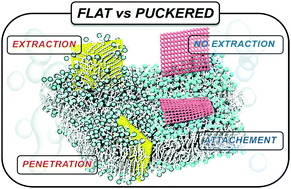Molecular mechanisms underlying the role of the puckered surface in the biocompatibility of black phosphorus†
Abstract
As a newly emerging two-dimensional material, black phosphorus (BP) has received broad attention in the field of biomedical applications. Prior to its clinical application, its cytotoxicity to cells should be carefully evaluated; however, this field is still in its infancy. Motivated by this, we performed molecular dynamics (MD) simulations to systematically investigate the potential mechanisms of the cytotoxicity of BP to the lipid membrane, including lipid extraction, penetration into the membrane, and the impacts of BP on the physical properties of the membrane. Surprisingly, we observed that BP could not extract lipid molecules from the membrane. The thermodynamic analyses suggested that the puckered surface structure could weaken the interactions between BP and lipid molecules, thus inhibiting the lipid extraction. Additionally, through simulating the spontaneous interaction modes between BP and the lipid membrane, we found that the “passivated” edges of BP prohibited it from penetrating into the membrane. As a result, BP could only spontaneously lie parallel on the surface of the membrane, in which manner BP exerted little influence on the properties of the lipid membrane. To comprehensively appraise the cytotoxicity, we even artificially inserted BP into the membrane and compared the effects of BP and graphene on the properties of the membrane. Simulation results showed that the influences of the inserted BP on the lipid properties were much milder than those of graphene. Overall, the present work suggests that BP possesses distinctive biocompatibility benefiting from its puckered surface structure. This work provides a better understanding of the interactions between BP and the membrane, which may offer some useful suggestions for exploring strategies to improve the biocompatibility of nanomaterials.



 Please wait while we load your content...
Please wait while we load your content...